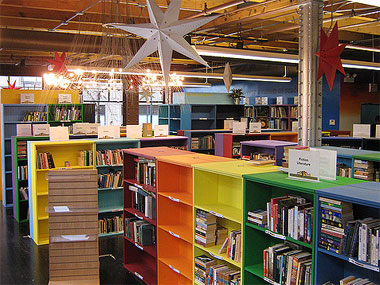Doing More With Less (original) (raw)
Feature Mon Feb 08 2010
Chicago's comprehensive history of community organization and social justice make it an optimal city for arts-based not-for-profits. The first inception of arts education began in Chicago at Jane Addams's Hull House in the late 1800s and in the past few years, education was one of only two job sectors to experience growth (the other was healthcare). Everything suffers in a weak economy and when it is difficult for people to meet their most basic needs, the arts can become a second priority. Chicago arts-based not-for-profits like Open Books and Marwen are reviewing their business plans, reevaluating their spending and committed to providing a creative haven for underserved youth.

In 2006, Stacy Ratner and Becca Keaty were in Ratner's basement developing a literacy outreach program based on the idea of selling used books in order to fund literacy programs. After accumulating 10,000 books by 2007, Open Books bought an office space in River North. Today, they have amassed a volunteer corps of 3,000 people and recently had the grand opening of their bookstore. Growth for a not-for-profit today is not easy. They must depend on the generosity of donors and volunteers and survival, let alone growth, must be done resourcefully. Anna Piepmeyer, Program Coordinator at Open Books, was proud to say that everything in the Open Books bookstore, from the paint to the furniture to the books themselves, was donated. "In times of economic downturn," she said, "When many of our partners are forced to cut programming or even close their doors, it's more important than ever to have a space in the community where people can go to learn about the issue of literacy. Our bookstore is that place." The economy has encouraged businesses to become more creative with their resources, which isn't always a bad thing. Ratner told Gapers Block that, "in some ways, the economic downturn has really helped us to focus on what's important, how we can do more with less."
Concentrating on how to do more when there's less to go around seems to be a common ambition for arts educators. Also nestled among the commercial art galleries of River North in a stylish building with exposed brick is Marwen, where Mary Jane Keitel, Director of Development and Communications spoke little about growth but instead, used words like "evaluation" and "reflection" to describe their business plan. "It may be different for other organizations that have been on a really expansive trajectory [but] I think last year did cause everybody to stop and reevaluate plans for growth," she said. Like most not-for-profits, Marwen was forced to take cost cutting measures but their creative problem solving allowed them to do so without eliminating any of their programs.
While it has become impossible to avoid conversation concerning the impact this recession has had on art programs, arts education institutions see themselves as solutions to a multitude of other issues in Chicago, especially the lack of adequate programming in schools. Piepmeyer rattled off some disheartening statistics: 40 percent of Chicago Public School (CPS) third through eighth graders fall below statewide reading standards, 44 percent of CPS high school students fail to graduate in four years, 61 percent of low income families have no children's books at home and 37 percent of adults in Chicago couldn't read a story to a child even if they had one. Therese Quinn, Associate Professor of Art Education at the School of the Art Institute of Chicago, explained that because the visual arts are exempt from standardized testing there is less urgency about the arts in schools. This means many schools in Chicago do not fund art programming and many teachers must pay for a class's art supplies themselves. Keitel said, "Marwen responded to some problems. There was a lack of accessibility and there continues to be a lack of accessibility of high-quality arts programming in Chicago. We are providing a solution." Both Keitel and Ratner gave credit to Chicago's inherent "can-do" and "entrepreneurial" spirit as an integral asset for the ability to create a response to these problems.
Whether it is literacy or the visual arts, a prominent goal these institutions have for these underserved Chicago youths is similar: helping them to develop a personal narrative in order to enrich their futures. "The second best gift you can provide kids is an education," said Marwen founder, Steve Berkowitz. "The first is a healthy self-image." Every project assigned to the students at Marwen revolves around issues of self-discovery like creating symbolic maps of their neighborhoods or creating an expression of their future that asks them to depict their lives in 10 years. Piepmeyer said, "many of the students we encounter have never had anyone tell them that their story is important. More than just encouraging students to write, we try to empower students to find their voices and become ambassadors in their communities."

Marwen student Bianca standing with her work
This feature is supported in part by a Community News Matters grant from The Chicago Community Trust and the John S. and James L. Knight Foundation.
